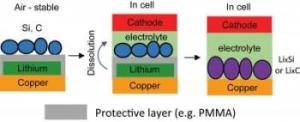Oct 24 2016
 This is an illustration showing the procedure to fabricate the trilayer electrode. (CREDIT: Yuan Yang, Columbia Engineering)
This is an illustration showing the procedure to fabricate the trilayer electrode. (CREDIT: Yuan Yang, Columbia Engineering)
A new method to enhance the energy density of lithium (Li-ion) batteries has been developed by Yuan Yang, an assistant professor of materials science and engineering at Columbia Engineering.
Because of the trilayer structure built by Yang, the battery is able to remain stable in ambient air so the battery lasts longer, and becomes cheaper for the manufacturer. This research work is expected to improvise the energy density of lithium batteries by 10 - 30%, and it has been presented online in Nano Letters.
When lithium batteries are charged the first time, they lose anywhere from 5-20% energy in that first cycle. Through our design, we've been able to gain back this loss, and we think our method has great potential to increase the operation time of batteries for portable electronics and electrical vehicles.
Yuan Yang, Assistant Professor, Columbia Engineering
During a lithium batteries first charge after production, a small quantity of the liquid electrolyte is reduced to a solid phase and forms a coating on the negative electrode of the battery. This process is irreversible and reduces the energy stored in the battery, and it is generally done before the batteries are shipped from a factory.
For the state-of-the-art negative electrodes, the loss is generally 10% and it can even reach to a value as high as 20 - 30% for next-generation negative electrodes that possess high capacity. This is because these materials possess high surface area and also have large volume expansions.
The huge initial level loss decreases the achievable capacity in a full cell and compromises the achievable energy density and the cycling life of these nanostructured electrodes.
The generally followed technique to compensate for this loss is to integrate certain lithium-rich materials in the electrode. However, most of these lithium-rich materials are not stable in ambient air. Manufacturing batteries in dry air that has no moisture at all is a very expensive process as compared to manufacturing in ambient air.
In order to overcome this problem, Yang has developed a new trilayer electrode structure that can fabricate lithiated battery anodes in ambient air. The researcher safeguarded the lithium with a layer of the polymer PMMA in order to save it from reacting with moisture and air.
Additionally, the researchers coated the PMMA with certain active materials like silicon nanoparticles and artificial graphite. The PMMA layer was later dissolved in the battery electrolyte, thus exposing the lithium surface to the electrode materials.
This way we were able to avoid any contact with air between unstable lithium and a lithiated electrode, so the trilayer-structured electrode can be operated in ambient air. This could be an attractive advance towards mass production of lithiated battery electrodes.
Yuan Yang, Assistant Professor, Columbia Engineering
The technique developed by Yang lowered the loss capacity in the silicon electrodes, from 13% to -15%, and in the graphite electrodes from 8% to -0.3%. The -15% value shows that there is more lithium than required, and the extra lithium can be utilized to enhance cycling life of batteries, since the excess lithium can be considered as compensation for capacity loss in successive cycles.
Because, for over two decades, the energy density, or capacity of lithium-ion batteries has been raising 5-7% annually, Yang's results suggest a solution to enhance the capacity of Li-ion batteries. The researcher and his team are now trying to decrease the thickness of the polymer coating so that it can occupy a smaller volume in the lithium battery, and can scale up the technique developed by him.
This three-layer electrode structure is indeed a smart design that enables processing of lithium-metal-containing electrodes under ambient conditions. The initial Coulombic efficiency of electrodes is a big concern for the Li-ion battery industry, and this effective and easy-to-use technique of compensating irreversible Li ion loss will attract interest.
Hailiang Wang, Assistant Professor of Chemistry, Yale University